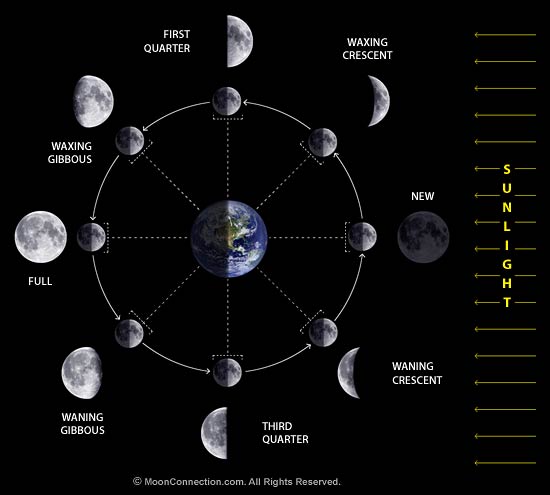Guiding Question: What Causes the moon phases?
Directions:
· For the model place the flashlight about one meter away from Earth.
· Then place the moon between the Earth and the sun, because that’s where it is.
· After you did that observe the moon as if you are standing on Earth.
· Then sketch what you see of the moon in your notebook from four different points.
· Record your observations of the moon when moved 1/4th of the way around the Earth in orbit, ½ of the way around the Earth and then 3/4th of the way around the Earth in orbit.
Positions:
· Move the moon one-fourth of the way around Earth in a counter-clockwise direction.
· More the moon half of the way around Earth in a counter-clockwise direction.
· More the moon three-fourths of the way around Earth in a counter-clockwise direction.
These are the phases of the moon:

As you can see in the pictures the new moon is completely dark, because its actual position is behind the Earth and there is no sunlight there. The Waxing Crescent has a bit of sunlight, the First Quarter is half full of sunlight (not half-empty, that's just being pessimistic), the Waxing Gibbous has more sunlight than darkness, the Full Moon has complete sunlight!

The diagram above shows and symbolizes all the phases of the moon as we see them from Earth.
What did you notice about the phases of the moon?
Some things that I noticed were that the phases of the moon aren't very fast, in fact, they are pretty slow (in my head they are slow) I state this because it take the moon 29.9 days to go around the Earth
As we all might of learned or know the moon is around 4.5 million years old which is around the same age as the Earth, it doesn’t produce light on its own it reflects off of the sun. Depending on which phase the moon is located on people down here on Earth can see it in different shapes (Isn’t that cool?!) What I also learned is that we can’t see the other side of the moon unfortunately, we only see one side.
What I learned, which might be less... Or more... Or the same amount as the rest of the class has, was that the moon, very much like Earth, is 4.5 million years old, it doesn't produce or make its own light but it receives it by reflecting it off the sun. Depending on the phase of the moon, it (the moon) looks differently for us on Earth. What i also learned which i found the most interesting, was that we can not see the other side of the moon, unfortunately, or fortunately, we don't know if it is a good or bad thing, basically we can see only one side of the moon.
Why do we see different parts of the moon each night?
You see different parts, not sides, but different parts of the moon each night, just because as the moon revolves and goes around the earth, it reflects the light from the sun at different positions. If the moon didn't revolve around the Earth we would be seeing the same part of the moon each and every night, that meaning we would always see a full moon, or a new moon, etc. But the moon does move around Earth and thats why we do see different parts of the Moon although still only one side of it.
What is a lunar month?
A lunar month is the average time between successive new or full moons, equal to 29 days and a half days, specifically 29 days, 12 hours, 44 minutes
.
How does the Earth, Sun and Moon interact to cause so many things to occur?
As the planets orbit around the sun they always move, some might move/orbit faster than others and some might not. Without the sun around, we wouldn't have light, we would be living in darkness, and all the trees, plants and other living organisms wouldn't be able to function at all. Without the moon we wouldn't have tides and without the Earths tilt we wouldn't have any seasons.
What causes an eclipse and a tide?
Eclipses are caused by the Moon in its orbit passing either between the Earth and the Sun (solar eclipse) or through the Earth's shadow (lunar eclipse). The tides are caused by the gravitational attraction of the Moon (major factor) or Sun (minor factor, because it's farther away) as the Earth rotates on its axis.
No comments:
Post a Comment